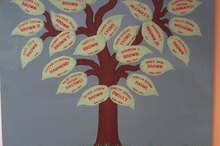What Constitutes a Family?
The definition of family often varies, depending on who is defining it. The government has a specific legal definition to define family, used for income taxes and insurance, for example. Within the confines of your own home with your family members, however, you might choose to define family in a different way that fits your loved ones.
Nuclear Family
The standard definition of a nuclear family includes a married father and mother and kids -- either biological or adopted. A nuclear family could also include a household with one parent and children, after death, divorce or if a parent chooses single parenthood. With industrialization and opportunities for geographic mobility, families tend to fragment. Adult children eventually move away from their parents to start their own nuclear families with the next generation of children.
- The standard definition of a nuclear family includes a married father and mother and kids -- either biological or adopted.
- A nuclear family could also include a household with one parent and children, after death, divorce or if a parent chooses single parenthood.
Blended Family
What Is Family Heritage?
Learn More
A blended family often has factors that make it different from a nuclear family. This type of family structure could occur after parents divorce. The children from the marriage will continue to need family structure, but the relationships between family members can become more complicated. Blended families can also result if two parents have never been married. The parents might consist of a mother and stepfather or a father and stepmother. Children in this family could be his, hers or theirs, resulting in step-siblings and half-siblings in the family. Children sometimes reside in homes full time, and, other times, the kids split their time between two parents’ households.
- A blended family often has factors that make it different from a nuclear family.
- The children from the marriage will continue to need family structure, but the relationships between family members can become more complicated.
Extended Family
Grandparents, aunts, uncles and cousins fit under the umbrella of extended family, states Social Worker Allan Schwartz, writing for Gracepoint, a mental health care facility 2. Typically, extended family members do not live together, but some situations exist when an extended family will choose to cohabitate 2. Economic struggles may necessitate extended families living together. Retirement and health issues also make living together beneficial for an extended family 2. Children often benefit from extended family because of the increased interaction with additional adults who love them 2. Sometimes extended family members help with child care responsibilities 2.
Nontraditional Family
The Average Grocery Budget for a Single Mother
Learn More
Love and commitment can serve as the connecting factor for families -- those that fall under the traditional description and those that do not. A family could also include parents of the same gender. Numbers of unmarried parents are increasing, and the number of children living with two married parents is decreasing, states the Pew Research Center 3. Children often feel loyalty to a nontraditional family, states the Pennsylvania Family Support Alliance. This type of family can also pose challenges for youngsters. A child might feel self-conscious about his "different" family, especially with peers. You can help your child by engaging in open communication about your nontraditional family and by fostering strong bonds between family members.
- Love and commitment can serve as the connecting factor for families -- those that fall under the traditional description and those that do not.
- Children often feel loyalty to a nontraditional family, states the Pennsylvania Family Support Alliance.
Legal Descriptions
The U.S. Census Bureau uses a strict definition for family. A family consists of at least two people related by marriage, birth or adoption and living in the same household. In addition, the Census Bureau defines a “household” as anyone living together, regardless of the relationship.
Related Articles
References
- HealthyChildren.org: The "Perfect" Family
- Gracepoint: The New Extended Family
- Pew Research Center: The Decline of Marriage and Rise of New Families
- "Borderline Personality Disorder." National Institute of Mental Health. 2011.
- Hoffman PD, Fruzzetti AE, Buteau E, Neiditch ER, Penney D, Bruce ML, Hellman F, Struening E. “Family Connections: A Program for Relatives of Persons With Borderline Personality Disorder.” Family Process. 44(2):217-225, 2005.
- Santisteban DA, Muir JA, Mena MP, Mitrani VB. „Integrative Borderline Adolescent Family Therapy: Meeting the Challenges of Treating Adolescents With Borderline Personality Disorder.” Psychotherapy: Theory, Research, Practice, Training. 40(4):251-264, 2003.
- Workgroup on Borderline Personality Disorder. “Practice Guideline for the Treatment of Patients with Borderline Personality Disorder.” American Journal of Psychiatry 158: 1-52, 2001.
Writer Bio
Kathryn Hatter is a veteran home-school educator, as well as an accomplished gardener, quilter, crocheter, cook, decorator and digital graphics creator. As a regular contributor to Natural News, many of Hatter's Internet publications focus on natural health and parenting. Hatter has also had publication on home improvement websites such as Redbeacon.









